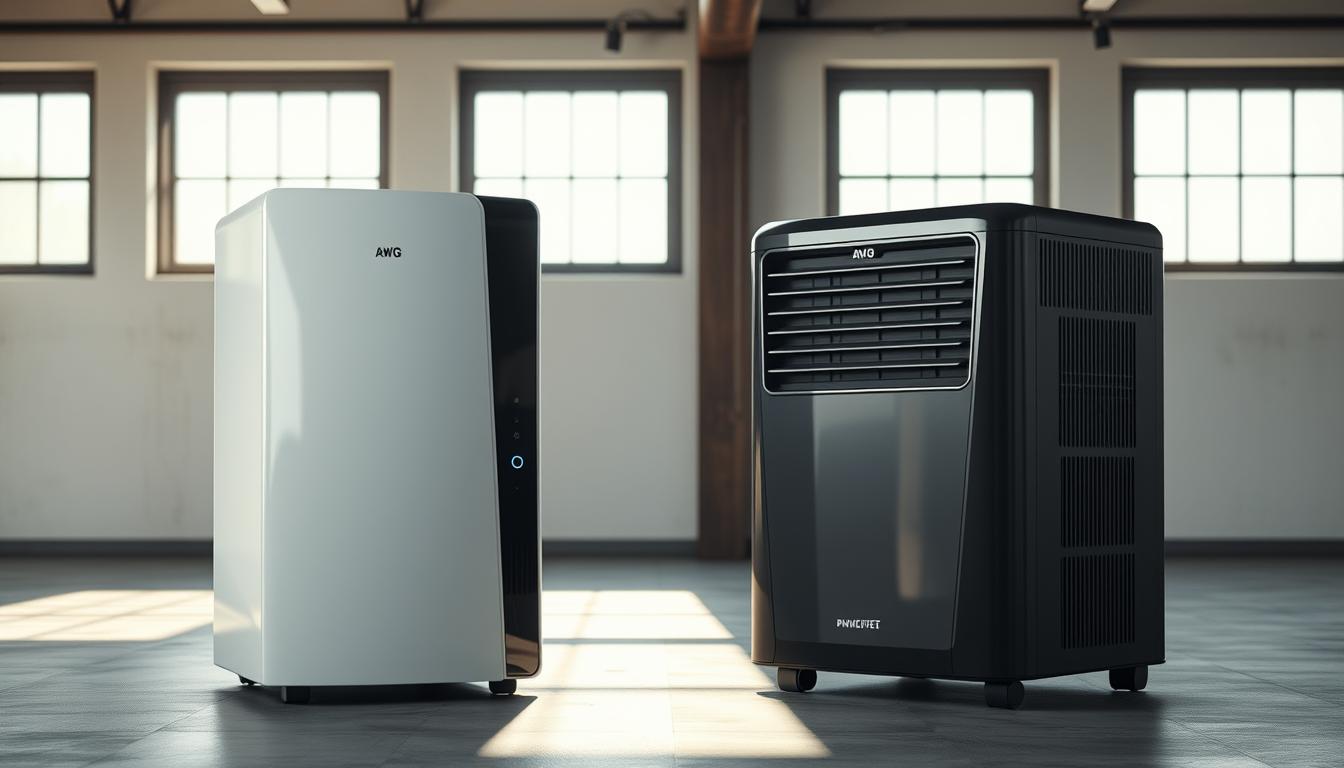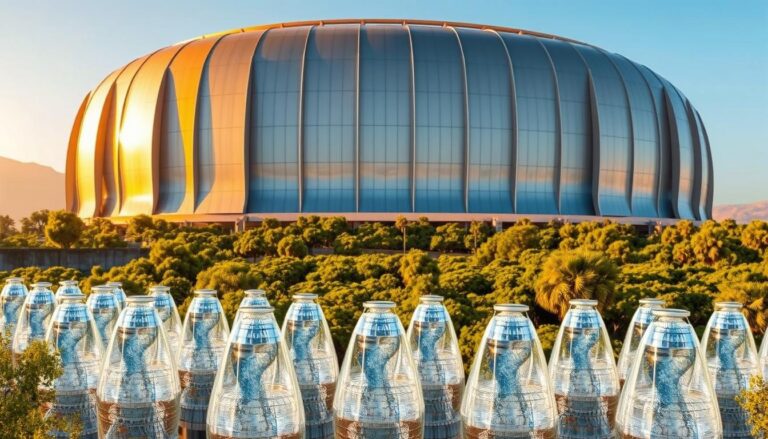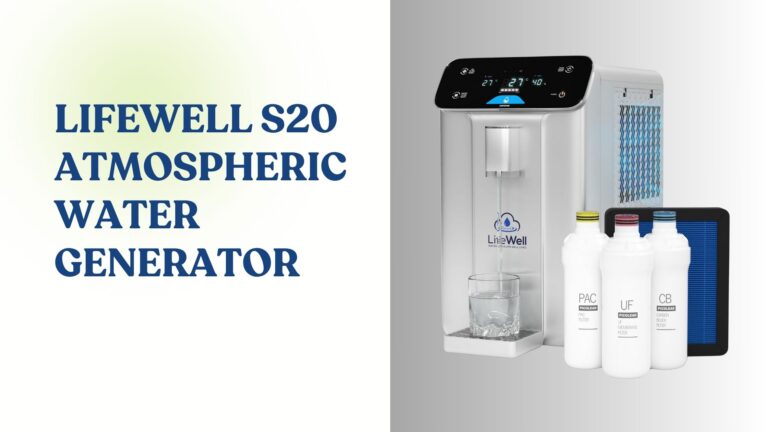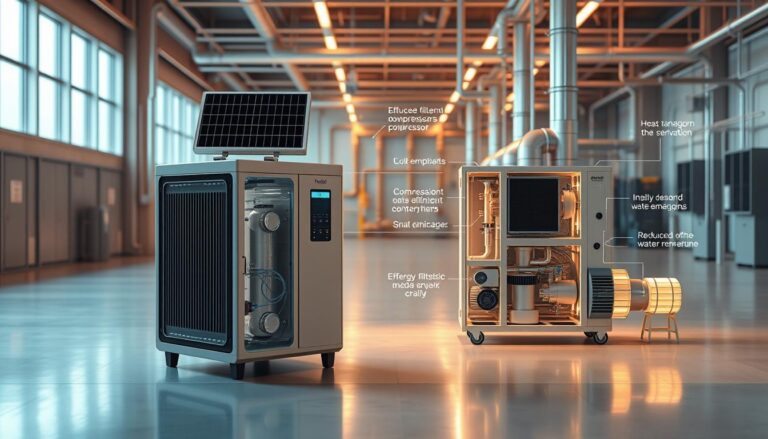Atmospheric Water Generator vs Dehumidifier: Which is Better?
Can a device that generates clean drinking water from the air be as effective as one that simply removes moisture? This question is at the heart of our comparison between two innovative technologies.
As we explore the differences between Atmospheric Water Generators (AWGs) and dehumidifiers, we’ll uncover which device is better suited for your needs, whether it’s for drinking water or controlling humidity.
The decision between these two devices hinges on their functionality and your specific requirements. Let’s dive into the details to make an informed choice.
Key Takeaways
- Understanding the primary function of AWGs and dehumidifiers.
- Comparing the benefits of clean drinking water vs humidity control.
- Evaluating device efficiency and energy consumption.
- Assessing maintenance needs and costs.
- Determining the best device for specific user needs.
What Are Atmospheric Water Generators and Dehumidifiers?
Understanding the basics of atmospheric water generators and dehumidifiers is crucial in determining which device suits your needs. Both devices interact with air humidity, but their purposes and functionalities differ significantly.
Defining Atmospheric Water Generators
An atmospheric water generator (AWG) is a device that harvests water from the air, even in arid environments, by condensing and filtering the water vapor. AWGs produce potable water, making them a viable solution for areas where clean drinking water is scarce. According to recent data, AWGs can generate significant amounts of clean water, making them an attractive option for both residential and commercial use.
Defining Dehumidifiers
A dehumidifier is an electrical appliance that reduces the humidity in the air, typically used to prevent mold growth and maintain a comfortable indoor environment. Dehumidifiers work by drawing in moist air, removing the moisture, and releasing dry air back into the environment. The collected water is usually not considered potable without additional treatment.
Initial Similarities and Differences
At first glance, both devices seem to manipulate air humidity. However, their primary objectives are different: AWGs aim to produce clean drinking water, while dehumidifiers focus on controlling indoor humidity levels. While both devices can extract water from the air, the quality and purpose of the extracted water vary significantly between the two technologies.
The key similarities lie in their ability to interact with air humidity and their potential to provide benefits in terms of water collection and humidity control. Nonetheless, understanding their distinct functionalities is essential for choosing the right device for specific needs.
How Atmospheric Water Generators Work
Atmospheric Water Generators (AWGs) operate on a fascinating principle, harnessing moisture from the air to produce clean water. This process involves several key technologies that work in tandem to deliver fresh water.
Condensation Technology in AWGs
The core of AWG technology lies in its condensation capability. By cooling the air to its dew point, AWGs cause the water vapor to condense into liquid water. This process is efficient and reliable, making AWGs a viable option for various environments.
Advanced Filtration Systems
After condensation, the water is passed through advanced filtration systems to remove any impurities. These systems often include UV treatment, activated carbon, and other technologies to ensure the water is safe for drinking.
Water Collection and Storage Mechanisms
The filtered water is then collected and stored in tanks for later use. The design of these storage mechanisms is crucial for maintaining water quality and preventing contamination.
| AWG Component | Function |
|---|---|
| Condensation Unit | Converts water vapor into liquid water |
| Filtration System | Removes impurities from the condensed water |
| Storage Tank | Stores the filtered water for consumption |
In summary, AWGs use a combination of condensation technology, advanced filtration, and proper storage to produce clean drinking water from atmospheric moisture.
How Dehumidifiers Function
The functionality of dehumidifiers revolves around their ability to extract moisture from the air. This process is crucial in maintaining a comfortable and healthy indoor environment by preventing the growth of mold and mildew.
Moisture Extraction Process
Dehumidifiers work by drawing in humid air, which then passes over a cold coil, causing the moisture to condense into water. This water is collected in a tank or drained away, depending on the model.
Collection Buckets and Drainage Options
Most dehumidifiers come with a collection bucket that stores the extracted water. Some models also offer continuous drainage options, allowing for a more convenient and hands-free operation.
Humidity Control and Settings
Modern dehumidifiers often feature adjustable humidity settings, enabling users to control the desired humidity level in their space. This not only improves comfort but also helps in reducing energy consumption.
| Feature | Description | Benefit |
|---|---|---|
| Moisture Extraction | Draws in humid air and condenses moisture | Reduces humidity levels |
| Collection Bucket | Stores extracted water | Easy to empty and clean |
| Continuous Drainage | Allows for direct drainage | Convenient and reduces maintenance |
By understanding how dehumidifiers function, users can better appreciate their role in maintaining a dry and comfortable indoor environment. Whether through moisture extraction or humidity control, dehumidifiers play a vital role in improving air quality.
Atmospheric Water Generator vs Dehumidifier: Key Differences
While both devices are used in relation to moisture in the air, their purposes and designs differ significantly. Understanding these differences is crucial for selecting the right device for your specific needs.
Primary Purpose: Water Production vs Humidity Control
The primary purpose of Atmospheric Water Generators (AWGs) is to produce clean drinking water by extracting moisture from the air, whereas dehumidifiers are designed to control humidity levels in a given space. AWGs are engineered to generate potable water, making them ideal for areas where access to clean water is limited.
In contrast, dehumidifiers are used to reduce moisture in the air, preventing mold growth and reducing humidity-related discomfort. They are commonly used in basements, bathrooms, and laundry rooms.
Design, Size, and Capacity Variations
AWGs and dehumidifiers vary significantly in design, size, and capacity. AWGs are often larger and more complex due to their advanced filtration systems, whereas dehumidifiers are generally more compact and straightforward in design.
| Feature | AWG | Dehumidifier |
|---|---|---|
| Primary Purpose | Water Production | Humidity Control |
| Design Complexity | Advanced Filtration | Simple Moisture Extraction |
| Typical Use Cases | Drinking Water Generation | Humidity Reduction |
Operational Requirements and Limitations
AWGs require more energy and maintenance compared to dehumidifiers due to their complex filtration and purification systems. Dehumidifiers, on the other hand, are generally easier to operate and maintain, with fewer operational limitations.
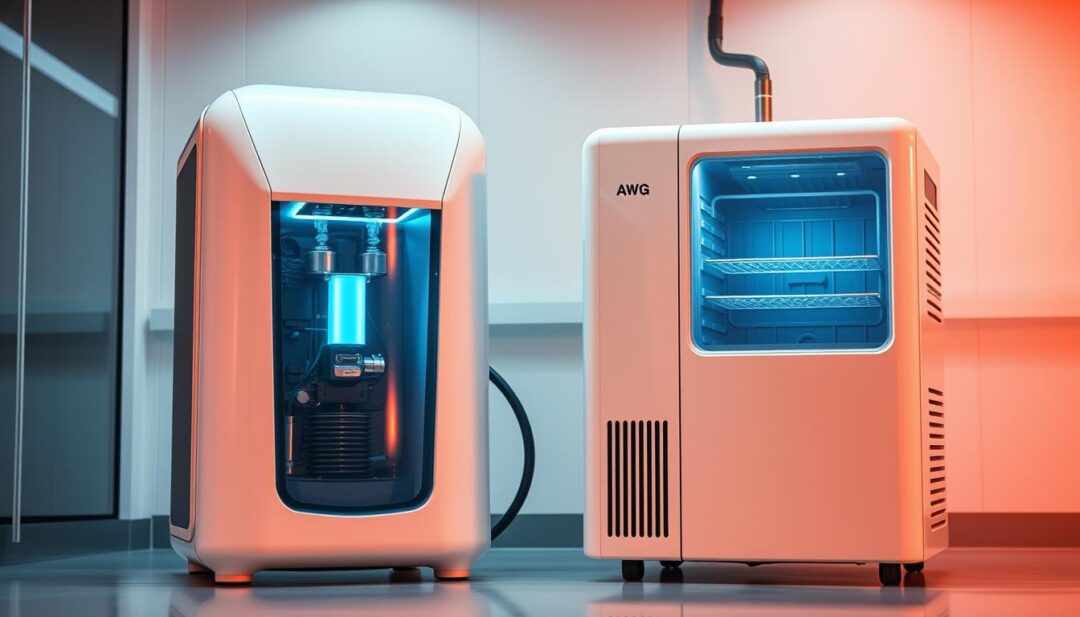
By understanding these key differences, you can make an informed decision about which device is best suited for your needs, whether it’s for generating clean drinking water or controlling humidity levels.
Water Quality and Safety Comparison
Understanding the water quality produced by Atmospheric Water Generators (AWGs) and dehumidifiers is crucial for making an informed decision.
Drinking Water Standards in AWGs
AWGs are designed to produce potable water that meets or exceeds drinking water standards. They utilize advanced filtration and purification technologies to remove contaminants and pathogens, ensuring the water is safe for consumption.
Why Dehumidifier Water Isn’t Potable
Water collected from dehumidifiers, on the other hand, is not considered safe for drinking without proper treatment. This water can contain bacteria, mold, and other contaminants that are not removed by the dehumidification process alone.
Filtration and Purification Technologies
The key to AWGs producing safe drinking water lies in their advanced filtration systems, which often include:
- Activated carbon filters to remove chlorine and improve taste
- Reverse osmosis membranes to eliminate dissolved solids
- UV light disinfection to kill bacteria and viruses
These technologies combined ensure that the water produced by AWGs is not only clean but also safe to drink.
In summary, while both devices extract water from the air, AWGs are specifically engineered to produce water that is safe for drinking, unlike dehumidifiers.
Energy Efficiency and Operating Costs
When considering Atmospheric Water Generators and dehumidifiers, understanding their energy efficiency and operating costs is crucial. Both devices consume energy, but their efficiency and operating costs can vary significantly, impacting their overall value and suitability for different applications.
AWG Power Consumption Analysis
Atmospheric Water Generators are designed to produce clean drinking water from air humidity, a process that requires significant energy. The power consumption of AWGs can range from 500 to 4,000 watts, depending on their capacity and technology. According to a study published on PMC, the energy efficiency of AWGs is a critical factor in their overall performance and environmental impact.
Dehumidifier Energy Usage Patterns
Dehumidifiers, on the other hand, are primarily designed to control humidity levels in indoor environments. Their energy consumption varies widely, typically between 200 to 700 watts, depending on their size and dehumidifying capacity. Understanding the energy usage patterns of dehumidifiers is essential for assessing their operating costs and efficiency.
Long-term Cost Comparison
When comparing the long-term costs of AWGs and dehumidifiers, several factors come into play, including their initial purchase price, energy consumption, maintenance costs, and lifespan. The following table summarizes a basic comparison:
| Device | Average Energy Consumption (Watts) | Typical Operating Cost (per year) |
|---|---|---|
| Atmospheric Water Generator | 1,000 – 4,000 | $500 – $2,000 |
| Dehumidifier | 200 – 700 | $50 – $200 |
The table illustrates that while AWGs provide the additional benefit of generating clean drinking water, their energy consumption and operating costs are generally higher than those of dehumidifiers. This information is crucial for consumers deciding between these technologies based on their needs and priorities.
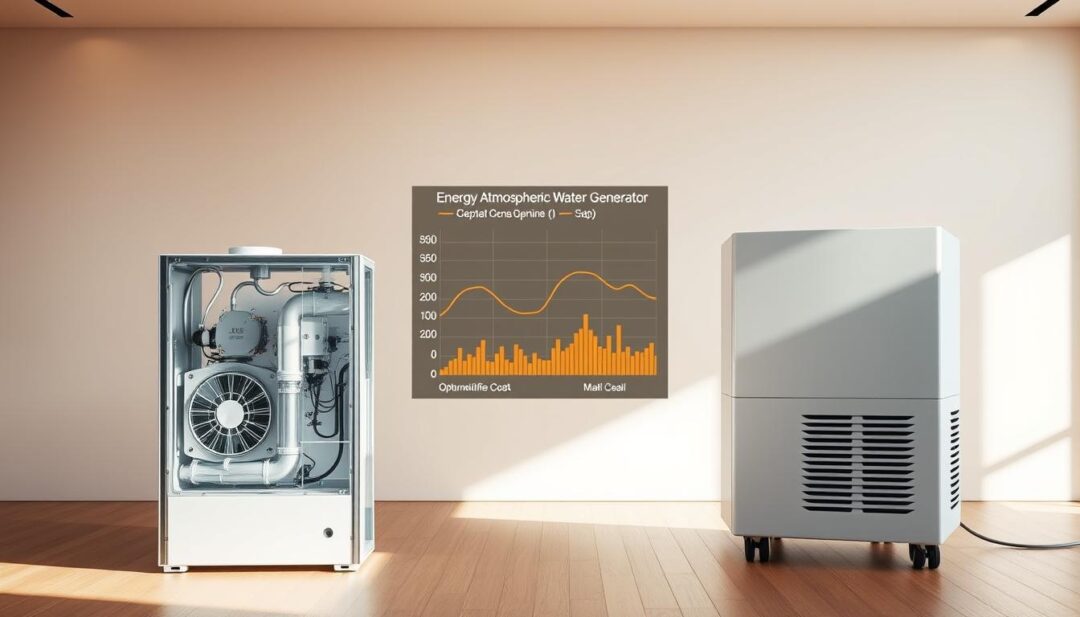
Installation and Maintenance Requirements
Understanding the installation and maintenance needs of AWGs and dehumidifiers is essential for their optimal performance. Both devices require careful setup and regular upkeep to function effectively.
Setting Up an Atmospheric Water Generator
Installing an AWG involves several key steps. First, choose a location with good airflow and access to electricity. Ensure the unit is level and securely positioned. Follow the manufacturer’s instructions for connecting the device to a power source and setting up any additional features such as filtration systems or remote monitoring.
Key considerations include:
- Ensuring the area around the AWG is clear of obstructions
- Regularly checking and replacing filters as needed
- Configuring the device according to the manufacturer’s guidelines
Dehumidifier Installation Considerations
Dehumidifier installation is generally straightforward. Place the unit in the room where humidity control is needed most, such as basements or laundry rooms. Ensure the dehumidifier is positioned to allow for easy access to the collection bucket and controls.
Important factors to consider:
- Positioning the dehumidifier to minimize noise disturbance
- Ensuring the collection bucket is correctly placed and regularly emptied
- Checking the device’s drainage options, such as continuous drainage through a hose
Maintenance Schedules and Procedures
Regular maintenance is crucial for both AWGs and dehumidifiers. This includes cleaning the units, checking for software updates, and inspecting for any signs of wear or damage. Refer to the manufacturer’s maintenance schedule for specific guidance.
By following these installation and maintenance guidelines, users can ensure their AWGs and dehumidifiers operate efficiently and effectively, providing the desired benefits of humidity control and clean water production.
Environmental Impact and Sustainability Factors
In today’s eco-conscious world, evaluating the sustainability of products like Atmospheric Water Generators (AWGs) and dehumidifiers is crucial. As we navigate our daily choices, understanding the environmental implications of these technologies becomes increasingly important.
Carbon Footprint Assessment
AWGs have been shown to reduce reliance on single-use plastics and have a lower carbon footprint compared to bottled water. This is a significant advantage, especially considering the growing concern over plastic waste. The production and disposal of plastic bottles contribute substantially to greenhouse gas emissions, making AWGs a more sustainable option in this regard.
Resource Consumption Patterns
Both AWGs and dehumidifiers consume electricity, but their overall resource consumption patterns differ. AWGs require energy to generate water from air, while dehumidifiers use energy to remove moisture. The efficiency of these devices can significantly impact their environmental footprint.
Eco-friendly Innovations
Recent innovations have focused on making both AWGs and dehumidifiers more eco-friendly. For instance, some AWGs now incorporate renewable energy sources and more efficient condensation technologies. Similarly, dehumidifiers with advanced humidity sensors can optimize their operation to minimize energy consumption.
By adopting these eco-friendly technologies, consumers can reduce their environmental impact while still benefiting from the functionalities of AWGs and dehumidifiers.
Ideal Applications for Atmospheric Water Generators
With their ability to generate water from air, AWGs offer solutions for different needs. These innovative systems are particularly useful in areas where access to clean drinking water is limited.
Climate and Environmental Considerations
AWGs are adaptable to various climates, making them suitable for use in different parts of the world. They can operate effectively in humid and dry environments, although their efficiency may vary based on the ambient temperature and humidity levels.
Residential and Commercial Use Cases
In residential settings, AWGs provide a reliable source of clean drinking water, reducing reliance on bottled water. For commercial applications, such as in offices, hotels, and restaurants, AWGs can help reduce operational costs associated with water procurement and management.
Off-grid and Emergency Applications
One of the most significant benefits of AWGs is their suitability for off-grid applications, where they can serve as a primary water source. They are also invaluable in emergency situations, such as natural disasters, where access to clean water is crucial.
Overall, the versatility of AWGs makes them an attractive solution for a wide range of applications, from residential and commercial use to off-grid and emergency scenarios.
When to Choose a Dehumidifier
In areas prone to dampness, dehumidifiers play a crucial role in preventing moisture-related issues. Excess humidity can lead to mold growth, musty odors, and damage to belongings. By controlling humidity levels, dehumidifiers help maintain a healthy indoor environment.
Humidity Control in Problem Areas
Dehumidifiers are particularly effective in areas with high humidity, such as basements and bathrooms. These spaces are prone to moisture accumulation, making them ideal locations for dehumidifier installation.
Basement, Bathroom, and Laundry Room Solutions
In basements, dehumidifiers prevent mold and mildew by controlling humidity. In bathrooms, they reduce moisture that can lead to mold and soap scum buildup. For laundry rooms, dehumidifiers help dry clothes faster and reduce musty smells.
Allergy and Mold Prevention Benefits
By reducing humidity, dehumidifiers help prevent mold growth and allergy-triggering dust mites. This creates a healthier living environment, especially for those with respiratory issues.
- Reduced mold and mildew growth
- Prevention of dust mites and allergy triggers
- Protection of belongings from moisture damage
Conclusion: Making the Right Choice for Your Needs
Choosing between an atmospheric water generator and a dehumidifier depends on your specific needs and circumstances. If your primary goal is to produce clean drinking water, an AWG is likely the better option. These systems are designed to extract water from the air and purify it, making them ideal for areas where access to clean water is limited.
On the other hand, if your main concern is controlling humidity levels in your home or office, a dehumidifier is the more suitable choice. Dehumidifiers are effective at removing excess moisture from the air, which can help prevent mold growth and reduce allergy symptoms.
When making the right choice, consider your specific requirements and weigh the benefits of each technology. By understanding the differences between atmospheric water generators and dehumidifiers, you can make an informed decision that meets your needs, whether it’s for drinking water, humidity control, or both. This comparison of atmospheric water generator vs dehumidifier will help you in making the right choice.

